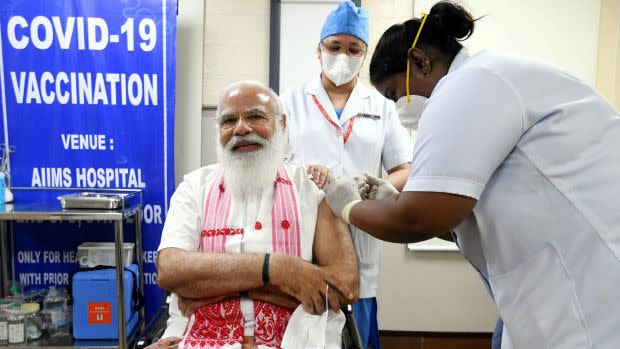How will the Covid-19 vaccination drive for India’s elderly work?

India has pushed the pedal on its Covid-19 vaccine drive.
Beginning today (March 1), Indians above the age of 60, and those below 60 but with co-morbidities can register to receive the vaccine. The government had announced this move on Feb. 24 but was yet to iron out the finer details.
Those who choose to take this route will need to pay Rs250 ($3.4) for each dose of the two-shot vaccine. Of this, citizens will pay Rs150 for the vaccine, and Rs100 as a service charge. Currently, the government buys the Serum Institute of India’s Covishield vaccine at around Rs200 a dose. This vaccine is made from the master seed of the Oxford-AstraZeneca vaccine.
The first batch of India’s own homegrown vaccine, Bharat Biotech’s Covaxin, also costs the government roughly Rs200. Only Covishield and Covaxin are currently authorised for emergency use in India.
The government also took a two-day break on Feb. 27 and 28 from the vaccination drive to upgrade its Co-WIN vaccine platform. Eligible beneficiaries can now self-register to take the Covid-19 shot, either at a paid private healthcare centre, or a government-run centre where the vaccine is free.
How to register on Co-WIN
Eligible users can register on the Co-WIN website with their mobile numbers and one-time passwords. At the time of registration, beneficiaries have to indicate one government-issued identity proof, such as Aadhaar number or passport, which will be mapped to their user ID.
Once registered, users can choose to receive the shot at their nearest Covid-19 vaccination centres (CVCs) on the date of their choosing. Private CVCs carry a “paid” marker next to their names. Bookings for both the first and the second dose of the vaccine will be made together, 28 days apart. Slots are open beginning today at 9am, and the vaccine will be administered up to 3pm on any given day.
For people between the ages of 45 and 59 who have co-morbidities, a form specifying the nature of their illness needs to be signed by a practising physician to confirm their place in the vaccination drive. This will then need to be uploaded on the Co-WIN website.
The government has now brought out a list of co-morbidities that qualifies people between the ages of 45 and 59 to receive the vaccine. Those aged 60 and above are automatically eligible.
Families can also register up to four beneficiaries at a time.
For those unable to access the website, a walk-in registration system has also been put in place at the CVCs. The process remains the same but will be carried out offline.
The worry, though, is whether people will come forward to take the vaccine.
Overcoming vaccine hesitancy
Covaxin’s hasty approval and the reports of adverse events after immunisation from the vaccines has led to a degree of hesitancy in India. So far, India has been vaccinating its healthcare and frontline workers, some of whom were apprehensive about taking Covaxin.
Since Jan. 16, when India’s vaccination began, 11.55 million people have received at least the first dose, and 2.2 million have also received the second dose. Initially, only 4% those who were due to receive the second shot of the Covid-19 vaccine turned up for it. But the turnout improved gradually.
To counter this, prime minister Narendra Modi was the first to take a shot of Covaxin at Delhi’s All India Institute of Medical Sciences today.
Took my first dose of the COVID-19 vaccine at AIIMS.
Remarkable how our doctors and scientists have worked in quick time to strengthen the global fight against COVID-19.
I appeal to all those who are eligible to take the vaccine. Together, let us make India COVID-19 free! pic.twitter.com/5z5cvAoMrv
— Narendra Modi (@narendramodi) March 1, 2021
Sign up for the Quartz Daily Brief, our free daily newsletter with the world’s most important and interesting news.
More stories from Quartz:
